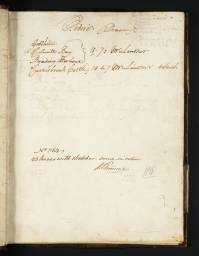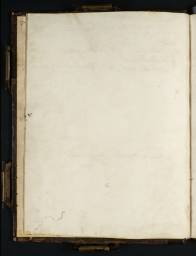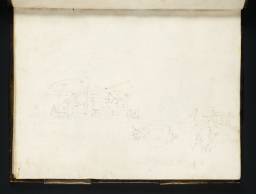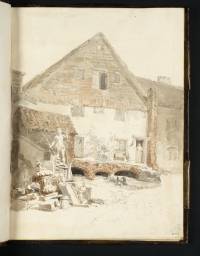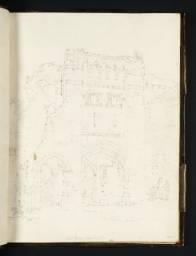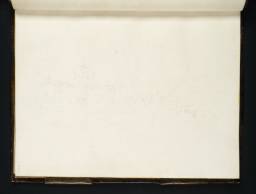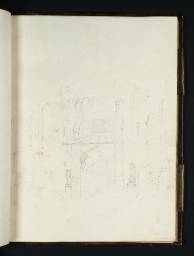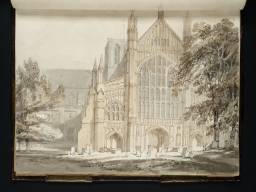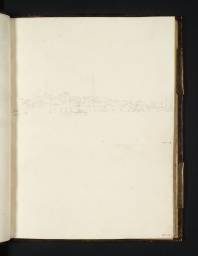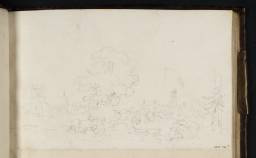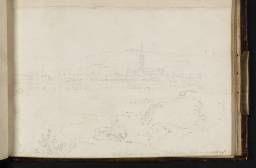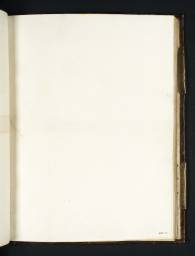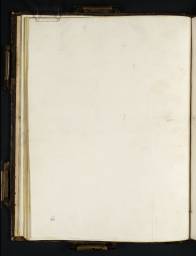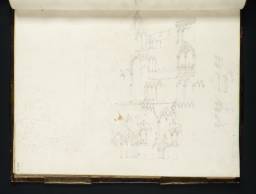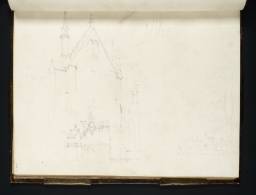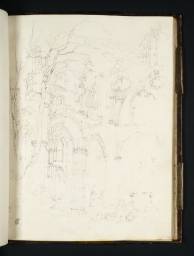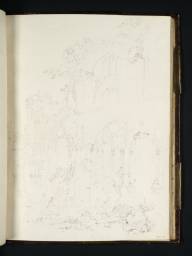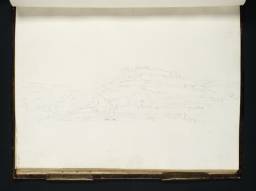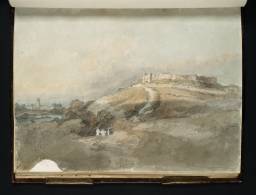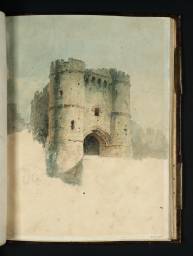Turner Bequest XXIV 1–52
Sketchbook bound in calf, with four brass clasps; Finberg records a ‘label on back’ (no longer extant) inscribed, presumably by Turner in pen and ink ‘95, Isle of Wight’
54 leaves of white wove paper and one fly-leaf; watermarks ‘E & P | 1794’ and ‘J WHATMAN’; page size 264 x 204 mm
Numbered 264 as part of the Turner Schedule, and endorsed on front flyleaf, recto (D41250), by the Executors of the Turner Bequest, Henry Scott Trimmer, Charles Lock Eastlake and John Prescott Knight, in ink ‘No 264 – | 42 leaves with sketches – some in colour | H.S. Trimmer’ and in pencil ‘C.L.E.’ | ‘JPK’
Inscribed by Turner inside front cover in pen and brown ink ‘Size of Stephill [sic] 12. by 8.’ top left, and in pencil ‘Steephill – 12 |10 | 8’ top left
Blind-stamped inside front cover with Turner Bequest monogram top centre, inscribed by A.M. Hind in pencil ‘Paper cockled | in the flood, 1928.’ towards top left, stamped in black ‘XXIV’ top left and inscribed in pencil ‘XXIV’ top right
54 leaves of white wove paper and one fly-leaf; watermarks ‘E & P | 1794’ and ‘J WHATMAN’; page size 264 x 204 mm
Numbered 264 as part of the Turner Schedule, and endorsed on front flyleaf, recto (D41250), by the Executors of the Turner Bequest, Henry Scott Trimmer, Charles Lock Eastlake and John Prescott Knight, in ink ‘No 264 – | 42 leaves with sketches – some in colour | H.S. Trimmer’ and in pencil ‘C.L.E.’ | ‘JPK’
Inscribed by Turner inside front cover in pen and brown ink ‘Size of Stephill [sic] 12. by 8.’ top left, and in pencil ‘Steephill – 12 |10 | 8’ top left
Blind-stamped inside front cover with Turner Bequest monogram top centre, inscribed by A.M. Hind in pencil ‘Paper cockled | in the flood, 1928.’ towards top left, stamped in black ‘XXIV’ top left and inscribed in pencil ‘XXIV’ top right
References
In his Inventory of 1909 Finberg placed the Isle of Wight tour before the tour in South Wales, suggesting that Turner might have continued directly from the south coast westwards to Wells and the Severn crossing. By 1914 he had doubts about this,1 and when his biography of Turner was published in 1939 he confirmed a revised ordering of the tours, citing as evidence the engraving of Swansea in the Pocket Magazine, published 1st September 1795;2 he accordingly suggested that the South Wales tour took place in June–July, and the Isle of Wight tour in ‘August or September’.3
The Isle of Wight was a fashionably Picturesque location in the 1790s,4 and one motive for the Isle of Wight tour seems to have been a commission for views from the engraver John Landseer (1769–1852). Another important patron whose commissions can be seen directing Turner’s itinerary in this book is Sir Richard Colt Hoare (1758–1838) of Stourhead, Wiltshire, who asked him for a series of views in Salisbury, both of the cathedral and of other buildings in the town. This commission was to occupy Turner over the rest of the decade.
As Ian Warrell notes,5 Turner used the book to make drawings of a number of watermills – rustic, often dilapidated structures that epitomised the Picturesque aesthetic – including Winchester City Mill on folio 2 recto (D00408), Mottistone Mill on folio 39 recto (D00446; Turner Bequest XXIV 38) and, possibly, Ford Mill, Whitwell on folio 34 recto (D00441; Turner Bequest XXIV 33). He had already recorded several watermills in Wales; see the South Wales sketchbook (Tate D00562, D00563, D00579, D00584, D00592; Turner Bequest XXVI 10, 11, 26, 31, 38), and there are studies of mills among the loose sheets of this year as well; see Tate D00675, D00676, D00683 and D00687 (Turner Bequest XXVII N, O, V, XXVIII B).
It is evident that the order in which the leaves of this book have been bound is not the original one. Nevertherless, many of the subjects seem to be in an order that corresponds fairly satisfactorily to a logically planned tour. The subjects are most likely to have followed one another in the sequence of his tour, which began after his crossing of the Solent from Southampton (see folio 12 recto; D00418) to Cowes, and probably a boat ride up the estuary of the Medina to Newport. Immediately outside Newport he made a number of views of the historically important castle at Carisbrooke, where Charles I had been imprisoned after his defeat in the Civil War, on folios 24 recto, 25 recto and 26 recto (D00431–D00433; Turner Bequest XXIV 24, 25, 25a).
Turner then seems to have travelled east to Bembridge (see folio 51 recto; D00458; Turner Bequest XXIV 49) and thence along the south coast via St Lawrence (folio 30 recto; D00437; Turner Bequest XXIV 29), Chale (folio 28 recto; D00435; Turner Bequest XXIV 27), Mottistone (folio 39 recto; D00446; Turner Bequest XXIV 38) and Freshwater Bay (folio 40 recto; D00447; Turner Bequest XXIV 39), to the Needles (folio 43 recto; D00450; Turner Bequest XXIV 42), which were to figure in his first important oil painting, Fishermen at Sea, exhibited at the Royal Academy in 1796 (Tate T01585).6 He followed the coast round to Yarmouth and thence across to Newport, where he no doubt had time for drawing (folios 45 recto, 48 recto, 49 verso; D00452, D00455, D00456; Turner Bequest XXIV 44, 47, 47a) while he was waiting for the ferry back to Southampton.
James Dearden proposes a route that follows more closely the order of the subjects in the book, with Turner proceeding south from Carisbrooke to the coast, north to Bembridge and then across to the far west of the island, returning to Newport for the return journey.
While Winchester may have been a stopping place on the journey south it is possible that Salisbury was visited on the return journey, though not, as Finberg initially thought, en route for South Wales. However, Warrell suggests that the two cathedral cities were visited in turn on the way south,7 and this is a reasonable supposition.
An interesting new phase of Turner’s creativity was to be initiated by a second visit to the Isle of Wight in 1827, prompted by the patronage of his fellow Royal Academician the architect John Nash (1752–1835), with whom he was to stay at East Cowes Castle.
Alexander J. Finberg, ‘Some Leaves from Turner’s “South Wales” Sketch-book’, The Third Annual Volume of the Walpole Society: 1913–1914, Oxford 1914, p.90.
Alexander J. Finberg, The Life of J.M.W. Turner, R.A. Second Edition, Revised, with a Supplement, by Hilda F. Finberg, revised ed., Oxford 1961, p.29.
Technical notes
How to cite
Andrew Wilton, ‘Isle of Wight sketchbook c.1795–1800’, sketchbook, April 2012, in David Blayney Brown (ed.), J.M.W. Turner: Sketchbooks, Drawings and Watercolours, Tate Research Publication, December 2012, https://www

